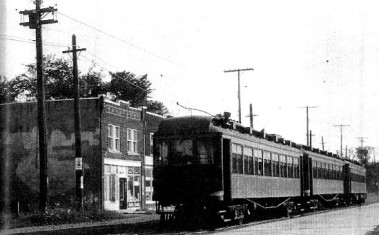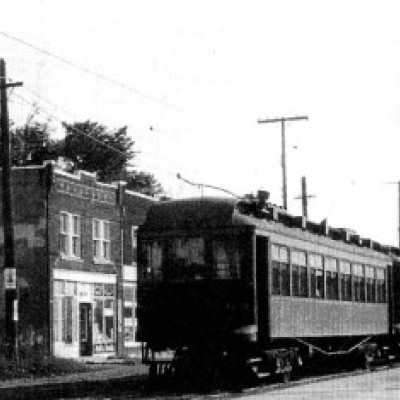 --February 20, 2019.
--February 20, 2019.
Transit service to the South Shore
Montreal evening newscasts often feature stories on Montreal West Island commuter problems However for life-long South Shore residents these problems were once part of daily routine.
The extended roots of the English-speaking community on the South Shore began with the construction of the Victoria Bridge, which was tied directly with the construction of the Grand Trunk Railway. The opening of the Victoria Bridge also shifted the South Shore economic pole away from Longueuil to St. Lambert which was now the gateway in to Montreal. Crossing the river was now an all-season event. New factories were opened around the Montreal side of the bridge along with working class tenement housing such as Griffintown.
While the Victoria Bridge was first used only for train traffic, passenger lanes opened in 1896. This allowed people to get away from the noise and grime of the city. With Montreal's industrial heart now based along the Lachine Canal and the Glenn Yards, it was an easy leap for workers to begin looking to move to the South Shore.
The Southern Counties Railway, Canada ‘s first commuter electric trolley line, would allow easy access into the city for work, and a means of returning home to the calm and cleaner air of the country in the evening.
A little train line that would open the South Shore as Montreal’s first off-island Suburb
Owned by then Grand Trunk Railway, and later the Canadian National Railway, the Montreal and Southern Counties Railway began operation in 1909, allowing for people to work in the city and live on the South Shore. The tramway would run from D’Youville Square at the bottom of McGill College Street in Old Montreal across the Victoria Bridge over into St. Lambert. From there, commuters could continue into Montreal South and Longueuil or switch trains to the then open country of Greenfield Park, Mackayville, and the junction villages of what is now St-Hubert.
 Most early commuters were trades-people, immigrants who came from the British Midlands. Access to the new tramway meant that they could purchase cheap land in the countryside far away from smoky industries and yet be able to commute to their jobs in less then an hour. Between 1911 and 1921, the South Shore population doubled -- mostly because of an influx of new English-speaking settlers. By the 1930s, a majority of the population of the communities of St. Lambert, Montreal South, Greenfield Park, MacKayville, Croydon, East Greenfield, Brookline and Pinehurst were English-speaking. Even Longueuil had a sizeable English-speaking population, and the newspaper Courrier du Sudwas bilingual up to the late 1950s.
Most early commuters were trades-people, immigrants who came from the British Midlands. Access to the new tramway meant that they could purchase cheap land in the countryside far away from smoky industries and yet be able to commute to their jobs in less then an hour. Between 1911 and 1921, the South Shore population doubled -- mostly because of an influx of new English-speaking settlers. By the 1930s, a majority of the population of the communities of St. Lambert, Montreal South, Greenfield Park, MacKayville, Croydon, East Greenfield, Brookline and Pinehurst were English-speaking. Even Longueuil had a sizeable English-speaking population, and the newspaper Courrier du Sudwas bilingual up to the late 1950s.
For almost 50 years the M&SCR was the centre of South Shore life. Workers would board the train in the morning to travel into Montreal and return each evening. For housewives it was the M&SCR that allowed them to travel into St. Lambert to shop and take their older children to high school. It was the M&SCR that brought mail from families back in Britain and the returning troops home from the war. Communities along the train line developed their own social network of support services through their local churches. Baseball was a popular weekend pastime as each community fielded a team to complete against each other with the families armed with picnic lunches cheering nearby. During the winter, the same players would lace up their skates and outdoor hockey rinks could be found in each village.
By the 1950s, with improvements to roads and more passenger cars and bus service, traffic along the M&SCR line was reduced. On October 13, 1956, the M&SCR had its last run and was soon replaced by commuter bus lines. However, for the early residents the M&SCR was always missed.
“During the winter we froze and on rainy days we got wet and boiled during the summer ... but we always knew the trains would get us there almost on time “… Joe-Ann Clark –long time St-Hubert resident
As we were setting up our new office in Greenfield Park, I brought along a heavy oak chair that was given to the D’Youville stationmaster on his retirement from the M&SCR after its last run on October 13, 1956. I thought it was appropriate as our Churchill Blvd office overlook were the original M&SCR streetcar would have passed with the first South Shore commuters to and from Montreal. Fitting as both ARC and the SSCPN focus is on English-speaking community development. And after all, it was the M&SCR that once lead the way in the development for many of our English-speaking South Shore communities.
Kevin Erskine-Henry is Community Outreach director for the Anglophone Referral Centre (ARC) and Chair of the South Shore Community Partners Network (SSCPN) which both work on South Shore community development programs )
([email protected]
You can visit two of the remaining Montreal Southern County Railway cars at the Canadian Railway Museum, 110, rue Saint-Pierre, Saint-Constant, Qc.
www.exporail.org
